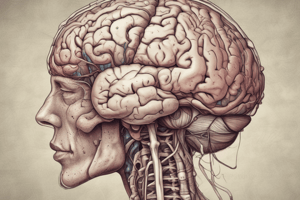Podcast
Questions and Answers
What is the main function of the limbic part of the brain?
What is the main function of the limbic part of the brain?
- Decodes sensory inputs
- Regulates emotions (correct)
- Controls movement and balance
- Processes visual information
Which part of the brain controls coordination and balance?
Which part of the brain controls coordination and balance?
- Cerebellum (correct)
- Parietal lobe
- Frontal lobe
- Temporal lobe
The dura mater provides support for blood vessels and delivers blood to the CNS.
The dura mater provides support for blood vessels and delivers blood to the CNS.
True (A)
_____ receives information in a neuron.
_____ receives information in a neuron.
Match the brain lobes with their functions:
Match the brain lobes with their functions:
What is the function of the myelin sheath in a neuron?
What is the function of the myelin sheath in a neuron?
What is the main function of the Limbic part of the brain?
What is the main function of the Limbic part of the brain?
What part of the brain is involved in controlling movement, attention, short-term memory, planning, and speech?
What part of the brain is involved in controlling movement, attention, short-term memory, planning, and speech?
The Arachnoid layer of the meninges allows for the exchange of ______ and waste.
The Arachnoid layer of the meninges allows for the exchange of ______ and waste.
Match the following parts of a neuron with their functions:
Match the following parts of a neuron with their functions:
Flashcards are hidden until you start studying
Study Notes
The Brain
- Comprised of three main parts: Brain Stem, Cerebellum, and Cerebrum
- Cerebrum is divided into four lobes: Frontal, Parietal, Temporal, and Occipital
Brain Stem
- Reticular: regulates sleep and wakefulness
- Periphery Sensory: connects sensory organs from the environment; signals go through thalamus and appropriate cortical areas
- Autonomic Sensory: responsible for perception of sensations
- Periphery Reward: regulates memory and behavior; connects to nucleus accumbens, ventral tegmental area, amygdala, and frontal cortex
- Limbic: regulates emotions; communicates with nucleus accumbens and frontal cortex to strengthen drug-seeking behavior
- Learning: responsible for learning and memory formation; connects sensory organs to thalamus, hippocampus, and finally frontal cortex
Cerebellum
- Controls coordination and balance
- Involved in emotion, motivation, and memory formation
Cerebrum Lobes
Frontal Lobe
- Controls movement, attention, short-term memory, planning, and speech
Parietal Lobe
- Processes information including touch, spatial awareness, and sensory inputs
Temporal Lobe
- Decodes sensory inputs, including visual and auditory information
- Involved in memory formation and language comprehension
Occipital Lobe
- Primarily responsible for processing visual information
The Meninges
- Three layers of tissue that protect the brain and spinal cord: Dura Mater, Arachnoid, and Pia Mater
Meninges Functions
- Dura Mater: provides support for blood vessels and delivers blood to the CNS
- Arachnoid: allows for the exchange of nutrients and waste
- Pia Mater: supplies the cerebral and spinal cord with oxygen and nutrients
- Pia Mater also contains cerebrospinal fluid, which protects the spinal cord
Neuron Anatomy
- Dendrites: receive information
- Nucleus/Soma: where DNA is made
- Axone: sends signals
- Myelon Sheath: insulates axon, allowing for faster signal transmission
- Axon Terminals: sends signals to other neurons
The Brain
- Comprised of three main parts: Brain Stem, Cerebellum, and Cerebrum
- Cerebrum is divided into four lobes: Frontal, Parietal, Temporal, and Occipital
Brain Stem
- Reticular: regulates sleep and wakefulness
- Periphery Sensory: connects sensory organs from the environment; signals go through thalamus and appropriate cortical areas
- Autonomic Sensory: responsible for perception of sensations
- Periphery Reward: regulates memory and behavior; connects to nucleus accumbens, ventral tegmental area, amygdala, and frontal cortex
- Limbic: regulates emotions; communicates with nucleus accumbens and frontal cortex to strengthen drug-seeking behavior
- Learning: responsible for learning and memory formation; connects sensory organs to thalamus, hippocampus, and finally frontal cortex
Cerebellum
- Controls coordination and balance
- Involved in emotion, motivation, and memory formation
Cerebrum Lobes
Frontal Lobe
- Controls movement, attention, short-term memory, planning, and speech
Parietal Lobe
- Processes information including touch, spatial awareness, and sensory inputs
Temporal Lobe
- Decodes sensory inputs, including visual and auditory information
- Involved in memory formation and language comprehension
Occipital Lobe
- Primarily responsible for processing visual information
The Meninges
- Three layers of tissue that protect the brain and spinal cord: Dura Mater, Arachnoid, and Pia Mater
Meninges Functions
- Dura Mater: provides support for blood vessels and delivers blood to the CNS
- Arachnoid: allows for the exchange of nutrients and waste
- Pia Mater: supplies the cerebral and spinal cord with oxygen and nutrients
- Pia Mater also contains cerebrospinal fluid, which protects the spinal cord
Neuron Anatomy
- Dendrites: receive information
- Nucleus/Soma: where DNA is made
- Axone: sends signals
- Myelon Sheath: insulates axon, allowing for faster signal transmission
- Axon Terminals: sends signals to other neurons
Studying That Suits You
Use AI to generate personalized quizzes and flashcards to suit your learning preferences.



